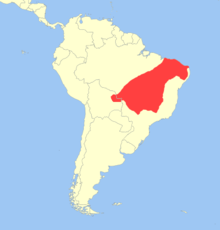Black-striped capuchin
| Black-striped capuchin[1] | |
|---|---|

| |
| Adult female and juvenile | |
| Scientific classification | |
| Domain: | Eukaryota |
| Kingdom: | Animalia |
| Phylum: | Chordata |
| Class: | Mammalia |
| Order: | Primates |
| Suborder: | Haplorhini |
| Infraorder: | Simiiformes |
| Family: | Cebidae |
| Genus: | Sapajus |
| Species: | S. libidinosus
|
| Binomial name | |
| Sapajus libidinosus Spix, 1823
| |

| |
| Range of S. libidinosus, excluding the subspecies cay and juruanus | |
| Synonyms | |
|
Cebus libidinosus | |
The black-striped capuchin (Sapajus libidinosus), also known as the bearded capuchin,[2] is a capuchin monkey from South America. It was the first non-ape primate in which tool usage was documented in the wild, as individuals have been seen cracking nuts by placing them on a stone "anvil" while hitting them with another large stone.[3] Adaptations to carrying large stones and fruit include strengthened back and leg muscles that permit the monkey to walk on its hind legs while carrying stones.[4] The black-striped capuchin has traditionally been considered a subspecies of the tufted capuchin.[1] On the contrary, the southern population here included in S. libidinosus has sometimes been considered another species, Azaras's capuchin (S. cay) (syn. S. paraguayanus).[5]
The black-striped capuchin is found in the Caatinga, Cerrado, and Pantanal of Brazil.[2] Some confusion surrounds the taxon juruanus, here included as a subspecies of the black-striped capuchin.[2] It has been considered to occur from the upper Juruá River east and south to Mato Grosso,[6] or alternatively entirely restricted to the region near the upper Juruá River.[7] In the latter case, its range would be surrounded by C. apella, leading to doubts over its true taxonomic status.[8]
Groves (2005) recognizes four subspecies:[1]
- Cebus libidinosus libidinosus
- Cebus libidinosus pallidus
- Cebus libidinosus paraguayanus
- Cebus libidinosus juruanus
In 2011, Jessica Lynch Alfaro et al. proposed that the robust capuchins such (formerly the C. apella group) be placed in a separate genus, Sapajus, from the gracile capuchins (formerly the C. capucinus group), which retain the genus Cebus.[9][10]
References
- ^ a b c Groves, C. P. (2005). Wilson, D. E.; Reeder, D. M. (eds.). Mammal Species of the World: A Taxonomic and Geographic Reference (3rd ed.). Baltimore: Johns Hopkins University Press. p. 137. ISBN 0-801-88221-4. OCLC 62265494.
- ^ a b c d "Sapajus libidinosus". IUCN Red List of Threatened Species. 2015. IUCN: e.T136346A70613080. 2015. doi:10.2305/IUCN.UK.2015-1.RLTS.T136346A70613080.en.
{{cite journal}}: Cite uses deprecated parameter|authors=(help) - ^ Fragaszy D.; Izar P.; Visalberghi E.; Ottoni E. B.; Gomes, de Oliveira M. (2004). "Wild Capuchin Monkeys (Cebus libidinosus) Use Anvils and Stone Pounding Tools". American Journal of Primatology. 64: 359–366. doi:10.1002/ajp.20085. PMID 15580579.
- ^ "Brazil's Cerrado". Mutant Planet. 11 August 2012. Science Channel.
- ^ "Sapajus cay". IUCN Red List of Threatened Species. 2015. IUCN: e.T136366A70612036. 2015. doi:10.2305/IUCN.UK.2015-1.RLTS.T136366A70612036.en.
{{cite journal}}: Cite uses deprecated parameter|authors=(help) - ^ Groves, C. (2001). Primate Taxonomy. Smithsonian Institution Press. ISBN 1-56098-872-X
- ^ Fragaszy D., Visalberghi E., & Fedigan, L. (2004). The complete capuchin. Cambridge University Press. ISBN 0-521-66116-1
- ^ "Sapajus apella". IUCN Red List of Threatened Species. 2015. IUCN: e.T39949A70610943. 2015. doi:10.2305/IUCN.UK.2015-1.RLTS.T39949A70610943.en.
{{cite journal}}: Cite uses deprecated parameter|authors=(help) - ^ Lynch Alfaro, J.W.; et al. (2011). "Explosive Pleistocene range expansion leads to widespread Amazonian sympatry between robust and gracile capuchin monkeys" (PDF). Journal of Biogeography. 39: 272–288. doi:10.1111/j.1365-2699.2011.02609.x. Archived from the original (PDF) on 26 February 2015.
{{cite journal}}: Unknown parameter|deadurl=ignored (|url-status=suggested) (help) - ^ Lynch Alfaro, J.W.; Silva, j.; Rylands, A.B. (2012). "How Different Are Robust and Gracile Capuchin Monkeys? An Argument for the Use of Sapajus and Cebus". American Journal of Primatology: 1–14. doi:10.1002/ajp.222007.
{{cite journal}}: Unknown parameter|lastauthoramp=ignored (|name-list-style=suggested) (help)

